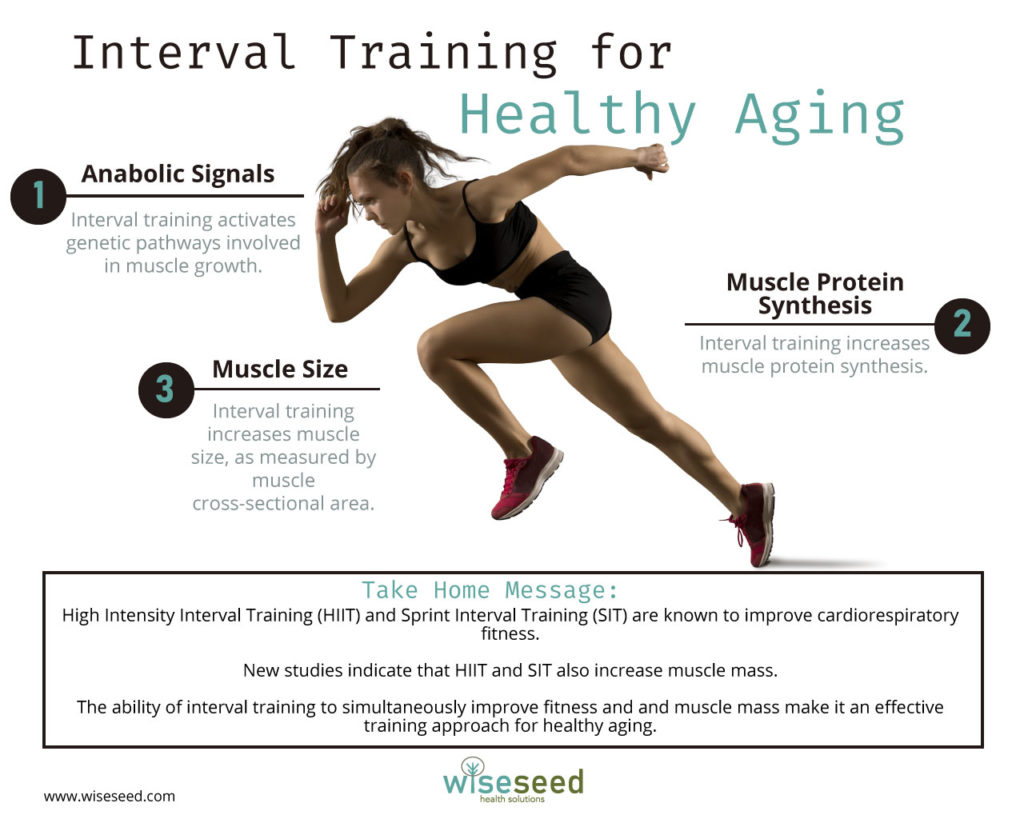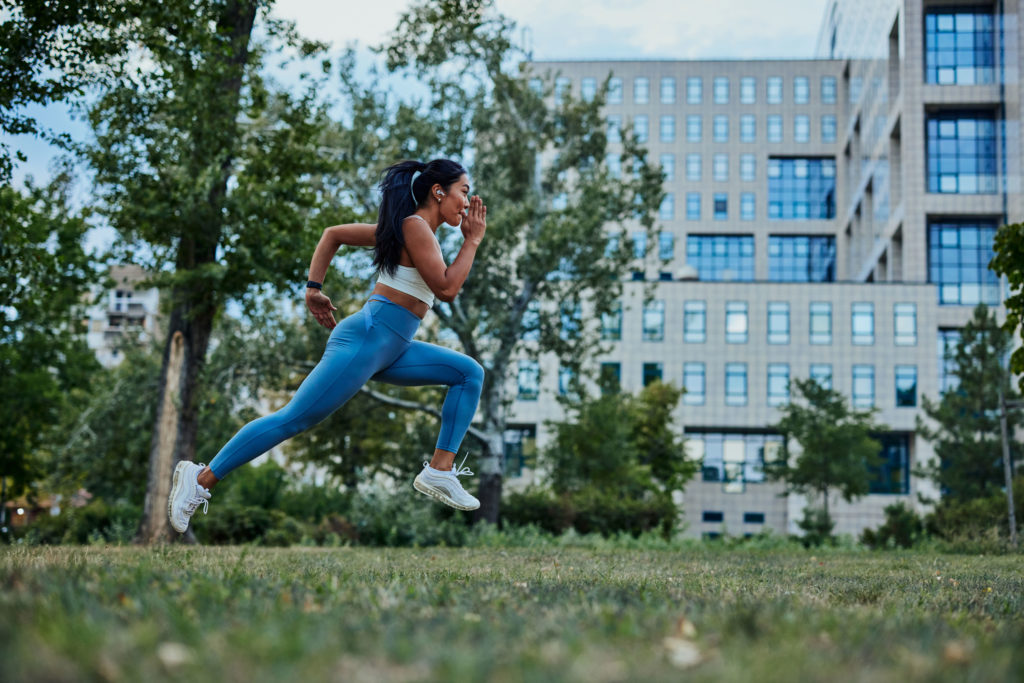Interval Training for Healthy Aging

The Challenge of Healthy Aging
Interval training is emerging as an important tool for healthy aging. This article outlines some of the challenges of healthy aging, and how you can use interval training to age successfully.
Cardiovascular Health and Successful Aging
Across the globe, cardiovascular disease remains the leading cause of death for people over the age of 40 (1). Unsurprisingly, improving your cardiovascular fitness reduces your risk of premature death (2, 3). Because premature death is the opposite of healthy aging, we highly recommend that you maintain your cardiorespiratory fitness!
Muscle Mass and Successful Aging
The grim reality is that after the age of 60, you start to lose muscle mass and strength at an alarming rate. Most people can expect to lose 1-2% of muscle mass, and a whopping 3% of muscle strength, as they enter their sixties (4)! This loss of muscle mass and strength not only causes unnecessary disability, but it also increases your chance of dying young (4). For this reason, maintaining your muscle mass and strength is essential for healthy aging.
Can High Intensity Interval Training (HIIT) and Sprint Interval Training (SIT) improve both cardiovascular health and muscle mass?
The two most widely used types of interval training are High Intensity Interval Training (HIIT) and Sprint Interval Training (SIT).
HIIT usually consists of brief periods (usually 2-4 min) of intense continuous exercise interspersed with short periods of rest or recovery (4). Examples of HIIT include hitting the heavy bag for 3-minute rounds, doing 500 m sprints on the rowing machine, or performing 2-4-minute speed intervals on the bike.
SIT involves shorter (30 seconds or less) ‘flat-out’ exercise bursts performed at 100% of your maximal power output (4). An example of SIT is performing a series of 100 m sprints, with 1-3 minutes of rest between each sprint.
Importantly, both high intensity interval training (HIIT) and sprint interval training (SIT) are well established methods for improving cardiovascular health (3). Moreover, there is growing evidence to suggest that both HIIT and SIT also improve your muscle mass (4). If true, this means that you could use interval training to improve your cardiorespiratory fitness and your muscle mass at the same time.
What the Researchers Did
To determine whether interval training does indeed increase muscle mass, Hawley and Colleagues analyzed the latest research on interval training and muscle growth (4).
What the Researchers Found
1. Several studies have shown that genetic and signaling pathways involved in muscle growth are activated after HIIT and SIT training (4). This supports the idea that interval training increases muscle mass.
2. For your muscles to grow, your muscle cells must increase their muscle protein synthesis over an extended time. Both HIIT and SIT increase muscle protein synthesis (4). This finding also supports the idea that interval training increases muscle mass.
3. An increase in muscle cross-section area (CSA) is a marker for increased muscle mass. In both young and older adults, HIIT increased muscle CSA as measured by MRI (4). Again, this finding supports the notion that interval training increases muscle mass.
Conclusion
It was already known that interval training improves cardiorespiratory fitness (3). Now, the review by Callahan et al shows that interval training may also improve muscle mass (4). Thus, it appears that interval training is an effective approach to simultaneously improve fitness and strength.
Putting it All Together
Before you ditch your current program and jump on the interval training bandwagon, it’s worth noting a few important points.
First, the gold standard for increasing muscle mass is the combination of resistance training plus consuming protein (5). This means lifting weights at near your maximum load for 4-12 repetitions while eating adequate amounts of protein to support muscle adaptation. Importantly, this tried-and-true approach increases muscle mass in both young and old adults (6).
A second, often under-appreciated benefit of resistance training is that it also alters your nervous system (7). In fact, the rapid early increases in strength experienced by ‘newbies’ are most likely due to neurological adaptations (7). Thus, resistance training increases both your muscle mass and your ability to efficiently activate your muscles. These two factors work in combination to increase your functional strength.
Taking these points together, we argue that an optimal training program for healthy aging should include both resistance and interval training. In addition, you will need a healthy diet that includes enough protein to support your training and recovery.
The Take Home Message
Interval training can simultaneously increase your cardiorespiratory fitness and your muscle mass. This makes interval training an effective training method for those interested in staying both fit and strong.
However, resistance training and a proper diet remain the gold standard for improving muscle mass and strength. Therefore, we recommend that you combine interval training with resistance training and a sensible diet. We believe that this to be an optimal approach for staying fit, strong and healthy throughout your life.
Please click on the link below to download your free PDF.

References and Further Reading
1. G. A. Roth, J. M. Geleijnse, Global, regional, and national age-sex-specific mortality for 282 causes of death in 195 countries and territories, 1980–2017 : a systematic analysis for the Global Burden of Disease Study 2017. The Lancet (British Edition) 392, 1736-1788 (2018).
2. S. Kodama et al., Cardiorespiratory fitness as a quantitative predictor of all-cause mortality and cardiovascular events in healthy men and women: a meta-analysis. Jama 301, 2024-2035 (2009).
3. S. Ito, High-intensity interval training for health benefits and care of cardiac diseases – The key to an efficient exercise protocol. World J Cardiol 11, 171-188 (2019).
4. M. J. Callahan, E. B. Parr, J. A. Hawley, D. M. Camera, Can High-Intensity Interval Training Promote Skeletal Muscle Anabolism? Sports Med 51, 405-421 (2021).
5. S. Joanisse et al., Recent advances in understanding resistance exercise training-induced skeletal muscle hypertrophy in humans. F1000Res 9, (2020).
6. D. R. Moore et al., Protein ingestion to stimulate myofibrillar protein synthesis requires greater relative protein intakes in healthy older versus younger men. J Gerontol A Biol Sci Med Sci 70, 57-62 (2015).
7. J. Škarabot, C. G. Brownstein, A. Casolo, A. Del Vecchio, P. Ansdell, The knowns and unknowns of neural adaptations to resistance training. Eur J Appl Physiol 121, 675-685 (2021).
Acknowledgements
Photos by Andrey Burmakin and milanmarkovic78
Disclaimer
The material displayed on this website is provided without any guarantees, conditions or warranties as to its accuracy.
Information written and expressed on this website is for education purposes and interest only. It is not intended to replace advice from your medical or healthcare professional.
You are encouraged to make your own health care choices based on your own research and in conjunction with your qualified practitioner.
The information provided on this website is not intended to provide a diagnosis, treatment or cure for any diseases. You should seek medical attention before undertaking any diet, exercise, other health program or other procedure described on this website.
To the fullest extent permitted by law we hereby expressly exclude all warranties and other terms which might otherwise be implied by statute, common law or the law of equity and must not be liable for any damages whatsoever, including but without limitation to any direct, indirect, special, consequential, punitive or incidental damages, or damages for loss of use, profits, data or other intangibles, damage to goodwill or reputation, injury or death, or the cost of procurement of substitute goods and services, arising out of or related to the use, inability to use, performance or failures of this website or any linked sites and any materials or information posted on those sites, irrespective of whether such damages were foreseeable or arise in contract, tort, equity, restitution, by statute, at common law or otherwise.

Ten Minutes is All You Need
Research has shown that ten minutes of moderate-to-vigorous exercise performed each day is enough to significantly reduce your risk of early death.

How to Become Anti-frail: Prevent Oxidative Stress
Combining a healthy, plant-based diet with exercise reduces unhealthy oxidative stress without overdosing your body with antioxidants.




